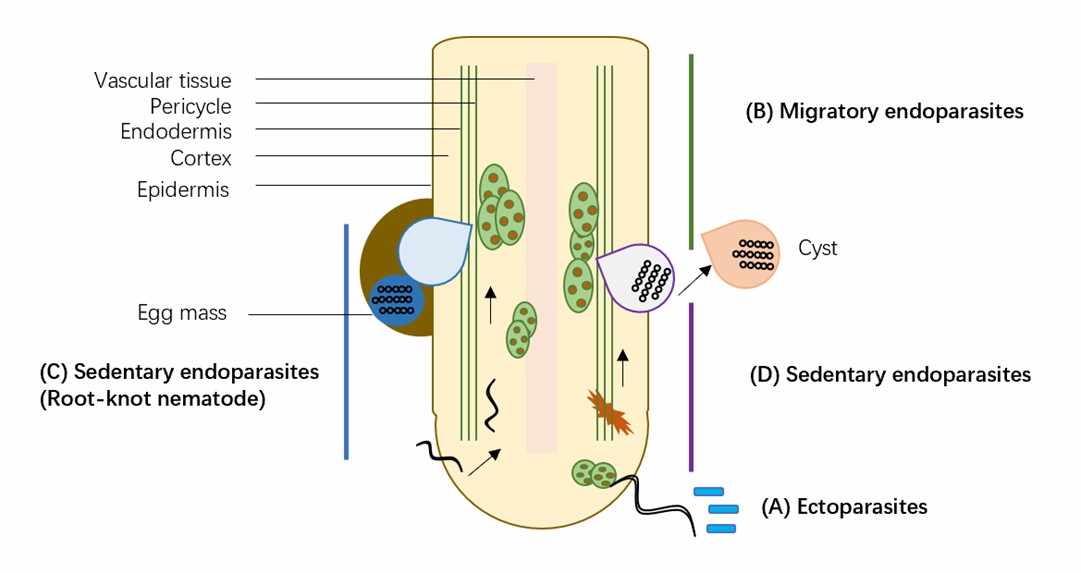Mechanism Analysis of Plant Immune Responses to Nematode Infection
Plant nematodes, one of the most destructive pests in agriculture, induce the redifferentiation of root cells into feeding cells that provide water and nutrients to these nematodes. Plants recognize nematode invasion through several different but complementary systems that trigger an immune response to nematode infection. Further, plant immune responses to nematodes include secretion of antinematode enzymes, production of antinematode compounds, strengthening of cell walls, production of reactive oxygen and nitric oxide, and hypersensitive response-mediated cell death.
Lifeasible provides mechanism analysis of plant immune responses to nematode infection to help our customers worldwide in the field of plant science. Our platform is equipped with cutting-edge facilities and professional experts to support research. Here, we provide various services according to customers' demands.
- In general, the economically important plant nematodes have a broad host range. They are highly virulent, which may possess sophisticated virulent strategies as they can infect many plants without inducing strong immune responses. However, recent progress in plant and nematode genomics has opened a way to understanding the plant's mechanisms for recognizing nematode infection.
 Fig.1 Infection strategies of plant nematodes.
Fig.1 Infection strategies of plant nematodes.
- Lifeasible provides analysis services for the recognition of plant nematodes, such as pathogen-associated molecular patterns (PAMPs) and damage-associated molecular patterns (DAMPs) derived from nematodes through pattern recognition receptors (PRRs).
- The fact that the plant nematode effector inhibits papain-like cysteine proteases (PLCPs) implies that its enzymatic activity is important in immunity against nematode. Besides, chitinases are also potentially important apo plastic enzymes in immunity against plant nematodes.
- We provide analysis services for anti-nematode enzymes in plants, including PLCPs, chitinases, and others, which are secreted into the apoplast to attack plant nematodes.
Plants produce secondary metabolites in response to nematode invasion. We provide analysis services for anti-nematode compounds in plants, including chlorogenic acid, phenylphenalenone anigorufone, flavonoids, indole glucosinolates, ethylene, and others.
- Since all plant nematodes must penetrate the cell wall for feeding, reinforcement of cell wall structure has been implicated as an effective defense as a physical barrier.
- We provide analysis services for the reinforcement of cell walls in plants, including lignin, callose deposition, and suberin accumulation, which may also reinforce cell walls and contribute to immunity against plant nematodes.
- The rapid production of reactive oxygen species (ROS), such as superoxide anion and hydrogen peroxide, is a conserved signaling response across kingdoms. In plants, it is induced at an early stage of plant nematode infection.
- We provide analysis services for ROS in plants, which have direct antimicrobial properties but also serve as signaling molecules to activate additional and complementary immune outputs.
Nitric oxide (NO) is an essential signaling molecule that has multiple functions in plants. We provide analysis services for NO and protease inhibitor-based immunity, which plays an active role in plant immunity to nematodes.
- HR-cell death, a type of programmed cell death induced after the invasion of avirulent pathogens to prevent the spread of biotrophic pathogens, also plays a crucial role in plant nematode immunity.
- We provide analysis services for HR-cell death in plants, inhibiting nematode development.
Lifeasible provides cost-effect, high quality, and hassle-free services to our clients worldwide. We provide our clients with direct access to our experts and prompt response to their inquiries. If you are interested in our services or have any questions, please feel free to contact us or make an online inquiry.
For research or industrial raw materials, not for personal medical use!
 Fig.1 Infection strategies of plant nematodes.
Fig.1 Infection strategies of plant nematodes.